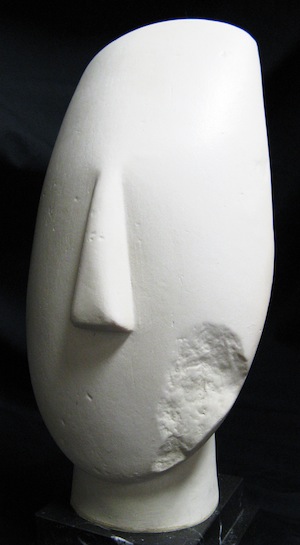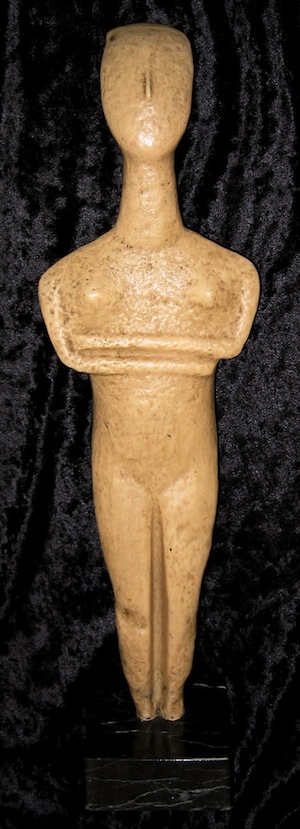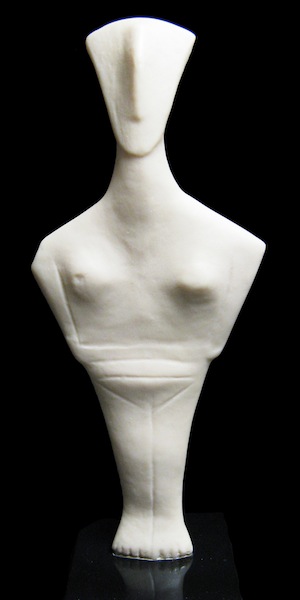The Cycladic civilization of the Aegean Sea flourished at about the same time as the early Egyptian and Mesopotamian civilizations and is considered the forerunner of the first truly European civilization in Greece. The sculpture produced by the artisans of the Cyclades was unique compared to the art being produced by the Egyptians and Mesopotamians. These sculptures are commonly called Cycaldic idols. Probably the most striking characteristic of Cycladic sculpture is its geometric, two-dimensional nature, which has a strangely modern familiarity.
Sculpture

Head of an Idol
Cycladic
replica: from the Louvre, Paris
date of the original: 2500-2000 BC
provenance of the original: island of Amorgos, Cyclades, Aegean Sea
description: Head with damage to the right side of face, cheek to chin. Resin replica; marble original. On base: height 33 cm, width 16 cm, depth 4 cm.
The head is of the same period as this idol, and is either a fragment of a larger idol (approximately 140 cm) or an originally separate item.
Like the abovementioned idol, it also demonstrates the economy of means and procedures which were employed in Cycladic sculpture: the nose just suffices to identify a sort of modified oval as a face. Seen from the rear, two miniature ears can have the same function. The eyes and the mouth of these idols were sometimes painted.

Idol
Cycladic
replica: from the Louvre, Paris
date of the original: 3000-2000 BC
provenance of the original: Cyclades, Aegean Sea
description: Standing female figure. Resin replica; marble original. On base: height 42.5 cm, width 13 cm, depth 8 cm.
This highly abstracted figure is the creation of a pre-Hellenic population of the Cycladic Islands in the second or third millennium BC. Most such figures are female, dubbed fertility goddesses with more imagination than evidence. (See also: Idol 2.) There are, in fact, also a few male figures of the same type. The latter are difficult to classify and have no label attached to them as yet. The function of the figures was perhaps religious as well as funerary--as the great number discovered in graves seems to indicate.
This figure was done with great sensitivity. Its flatness suggests two-dimensionality while the incurvations, slight protuberances and incisions suggest three-dimensionality.

Idol
Cycladic
replica: from the Louvre, Paris
date of the original: 3000-2000 BC
provenance of the original: island of Naxos, Cyclades, Aegean Sea
description: Standing female figure. Resin replica; marble original. On base: height 29 cm, width 10.5 cm, depth 3 cm.
This idol is a flatter, tenuous and less undulating figure than this idol. Its contour, the shape of the head and the nose are geometrically stylized with great emphasis.
Incisions replace modelling in many parts. The slender support of the statue, which unlike the abovementioned idol has little depth or mass, offers very limited possibilities for modelling. The general contour is triangular, the lower body merely serving as a trunk for the chest. This reflects a trend towards stylization rather than an intention towards realism.